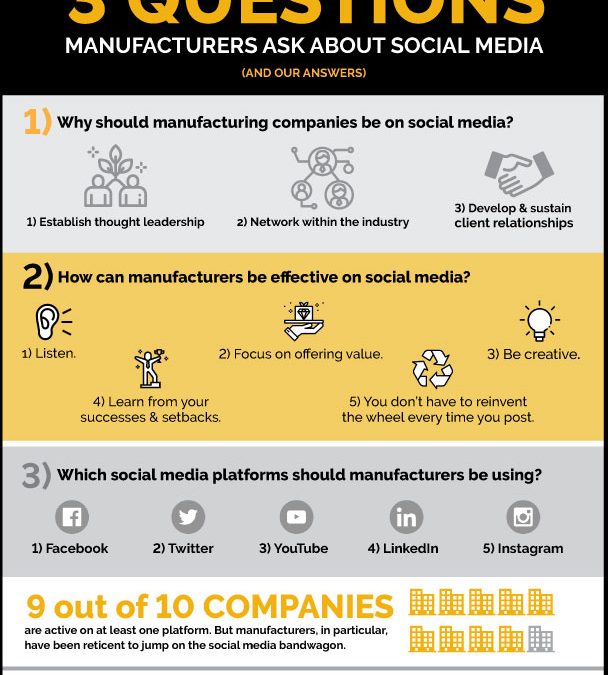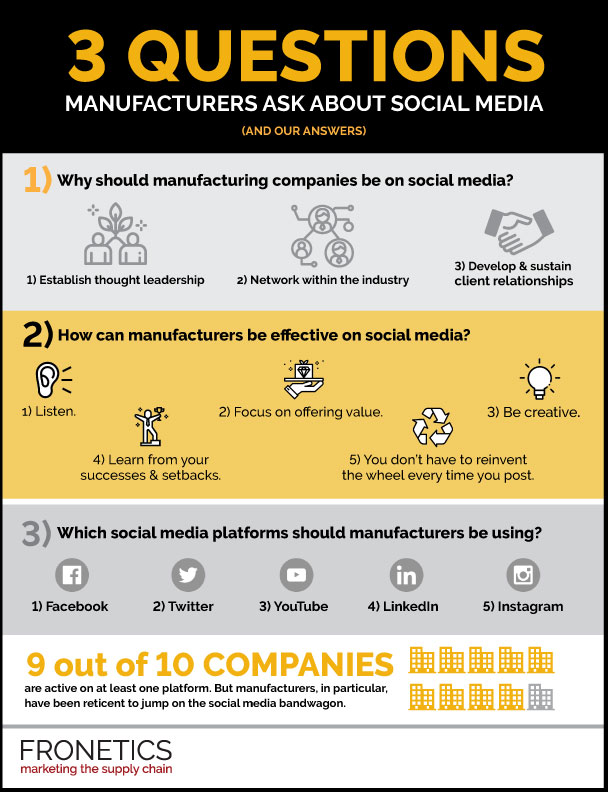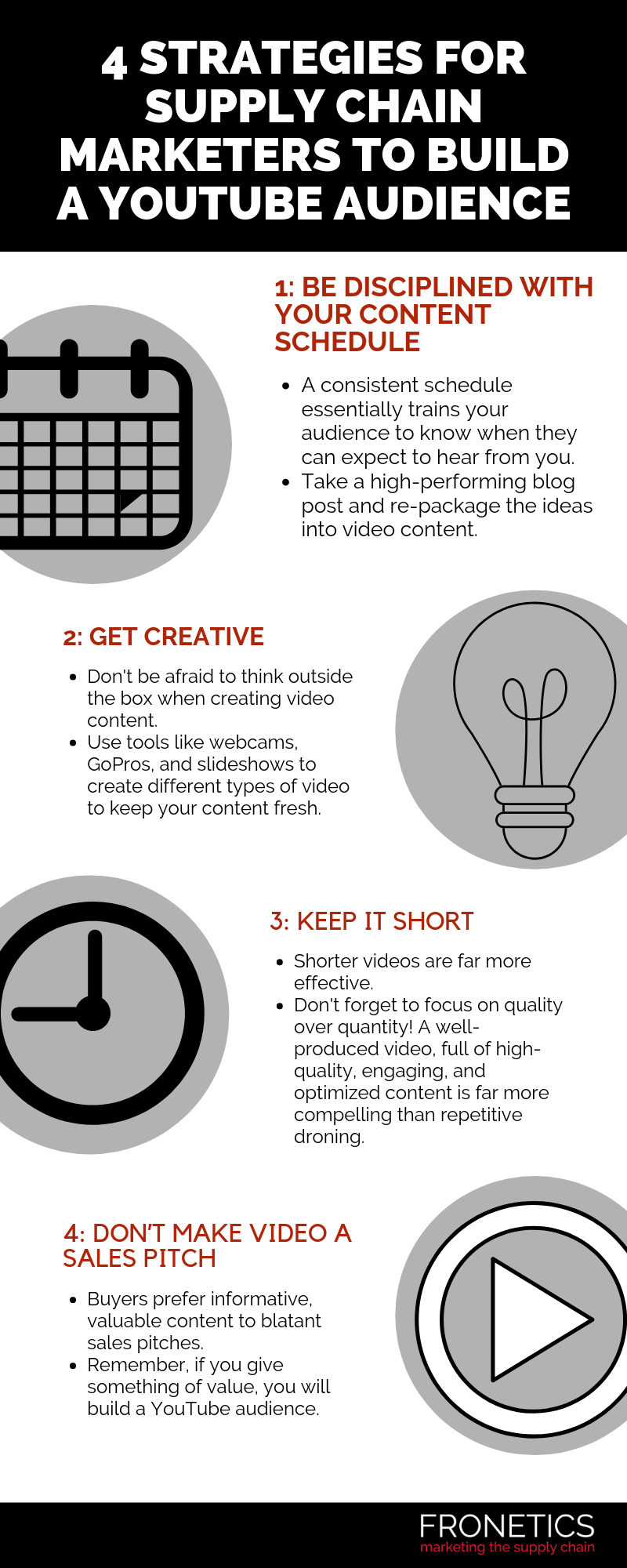
by Fronetics | Sep 18, 2019 | Blog, Marketing, Social Media, Video Marketing
Here are 15 social video marketing statistics that every supply chain marketer should be aware of in 2019.
Highlights:
- 87% of business use video as a marketing tool.
- 83% of marketers report that video gives them a good ROI.
- Social video marketing trends to be on the lookout for: live video and 1:1 personalized video.
If you believe everything you read, you might think that social video marketing has taken a bit of a hit in the past year or so. Largely thanks to Facebook’s well-publicized inflation of video view metrics, companies are naturally wary of investing in video creation and promotion on the platform.
But Facebook’s transgressions shouldn’t undermine marketers’ confidence in the future of social video marketing. Both expert analysis and hard numbers support the notion that video isn’t going anywhere. As digital media expert Michael Humphrey puts it, “All the major upward trends still wrap around video.”
According to Lux Narayan, CEO of independent social analytics company Unmetric, audiences “are longing for more interactive experiences as well as long-form storytelling that only video can best achieve.”
Here are 15 social video marketing statistics we think supply chain marketers should be aware of.
15 social video marketing statistics for 2019
- 47% of internet users have watched brand advertising videos on social media within the past 3 months. (Toluna)
- Of the social media users who have watched branded videos in the past 3 months, 43% watched on Facebook, 38% on YouTube, 18% on Instagram, and 13% on Twitter. (Toluna)
- 87% of businesses now use video as a marketing tool, up from 63% in 2017. (Wyzowl)
- 55% of people consume videos thoroughly – the highest percentage of any content type. (HubSpot)
- 30% of users prefer video ads to text or still image ads, while 52% report having no preference. (Only 18% prefer text or still image ads). (Toluna)
- 83%of marketers say video gives them a good ROI, up from 78% in 2018. (Wyzowl)
- 52% of consumers say that watching product videos makes them more confident in online purchase decisions. (Invodo)
- 68%of people say they’d most prefer to learn about a new product or service by watching a short video, over text-based articles (15%), infographics (4%), presentations and pitches (4%), and ebooks and manuals (3%). (Wyzowl)
- 48% of social media users have sought more information about a product or service based on social video marketing. (Toluna)
- 33% of survey respondents answered yes to having bought a product or service from a brand solely based on social video marketing. (Toluna)
- 88% of video marketers are satisfied with the ROI of their video marketing efforts on social media. (Animoto)
- 82% of social media users prefer live video from a brand to social posts. (Impact)
- 81% of marketers say video has helped them generate leads, and 84% say video has helped them increase traffic to their website. (Wyzowl)
- 61% of marketers have made more marketing videos in house in 2018 than they did in 2017. (Animoto)
- 67% of users said they would like to see more social video marketing in the future over other types of ads. The remaining 33% are indifferent, not opposed. (Toluna)
The future of social video marketing
Suffice it to say, the numbers bear out the fact that video marketing, and particularly social video marketing, is a trend that’s here to stay. Live video is increasingly popular, and savvy brands are incorporating it into their strategies.
In addition to live video, given the growing ease of shooting video on smartphones, another big trend is likely to be 1:1 video. Marketers can nurture leads via personalized video messages, rather than phone calls or emails, using video to offer additional content, product support, or simply to foster a relationship.
The bottom line is that video offers up the kind of engaging storytelling that users today want. And social media is the ideal distribution platform for video, making social video marketing a winning strategy.
Related links:


by Fronetics | May 30, 2019 | Blog, Current Events, Marketing, Social Media
Also, this month in social media news: Facebook shows marketing decline; Instagram introduces unfollower statistics for creators; and YouTube adds still-image ads.
Highlights:
- Facebook announces a new redesign that puts Groups at the center – and brands on the outskirts.
- For the first time in 5 years, Facebook marketing is in decline.
- Instagram is testing small changes that could make a big difference for brands.
It’s been a big month in social media news. Kicking things off, Facebook held its annual F8 developer conference, giving the world some insights into the platform’s future, including long-term goals. Just one week later, Social Media Examiner released its annual Social Media Marketing Industry Report, which showed a decline in Facebook marketing in general.
In the meantime, YouTube is rolling out a new development for advertisers: still image ads. LinkedIn has updated its Job Search tools, and Instagram is empowering creator accounts with data about unfollowers and new likes. Read on for a roundup of social media news from May 2019.
Facebook Holds Its Annual F8 Developer Conference
From April 30-May 1 in San Jose, CA, Facebook gave developers some glimpses into its long-term goals and strategies. Perhaps the biggest news from the conference is the complete redesign of both its desktop and mobile versions. While the redesign has some aesthetic changes, the important thing for marketers to know is that Facebook is now structuring itself around Groups. As Facebook reported, the new design “puts your communities at the center.”
It’s official: Facebook is departing from the News Feed focus, and instead continuing to turn toward being a more friends-focused platform. In the wake of Cambridge Analytica, Facebook is continuing its push to restore user confidence — and in doing so, it’s clearly demonstrating that Facebook is a decreasingly friendly place for brands. Marketers need to stay abreast of the ongoing changes and shift their Facebook strategies accordingly. Keep an eye on our monthly social media news roundups for updates.
New Report: Facebook Marketing Decline
The Social Media Marketing Industry Reportis out, and its findings offer some surprises — at least on the surface. In a reversal of trends from the past 5 years, there is a clear indication that marketers are turning away from Facebook. While this doesn’t mean that marketers are turning away from Facebook entirely, it does mean that they are diversifying their social advertising. One in 10 marketers indicated that they’ll be decreasing their organic marketing on Facebook, and only 51% plan to increase their organic activities, down from 62% in 2018.
LinkedIn Updates Its Job Search Tools
LinkedIn is continuing to build quietly on its success as a highly respected, professional platform. According to LinkedIn’s announcement of recent changes to its Jobs tools, “We’ve grown from 300,000 to 20 million job postings in the past five years, with members applying to 25 million jobs every week and a new hire made every 8 seconds using LinkedIn.”
The network has redesigned its Jobs section, with the goal of catering better to user needs. The homepage is now more streamlined and less cluttered, and more focused on advertising roles, making it easier for users to scan quickly through available opportunities. The platform is also revamping its job alerts system, giving users instant, personalized alerts about available opportunities. It’s also making its Salary Insights data available to all members.
Instagram Separates New Likes on Posts and Adds Unfollower Stats for Creator Accounts
Instagram is testing out some options that will help businesses easily see activity and take actions based on it. The platform is now sorting the Likes section for creator accounts into “Earlier” and “New” sections, helping businesses easily distinguish the latest activity. The feature has been on Android for several months but is new for iOS.
Similarly, Instagram creator accounts now have access data on followers and, notably, unfollowers. This is valuable data for marketers, as it provides context on content and overall account performance.
YouTube Adds New Still Image Ads
YouTubehas announced that it will soon begin providing non-video advertisers with a new still-image option that will appear within YouTube home feeds. “For a long time, advertising on YouTube meant your brand had to have a video or app ad,” says the announcement. “We’re excited to announce today that’s no longer the case.”
YouTube is calling the feature Discovery Ads, and it will use audience targeting to display ads to relevant users based on their activity. “Discovery ads are a simple and effective way to tap into the power of YouTube — and you don’t even need a video. Just upload your best images from your social campaign, then we’ll optimize your media mix for maximum performance across Gmail, Discover and the YouTube Home feed.”
What social media news caught your eye this month?
Related posts:


by Fronetics | May 1, 2019 | Blog, Content Marketing, Logistics, Manufacturing & Distribution, Marketing, Social Media, Supply Chain
We get many queries from manufacturers about social marketing — mostly, why and how should I use it — so here are our answers to the most-popular questions manufacturers ask about social media.
Highlights:
- Facilitate networking opportunities, thought leadership, and prospect/client relationships.
- Consider using popular platforms like YouTube and Instagram to engage users and drive website traffic.
- Don’t use social media to push your products.

(Made with Canva)
B2B operations have increasingly embraced social media as a strategic marketing tool. In fact, 9 out of 10 companies are active on at least one platform. But manufacturers, in particular, have been reticent to jump on the social media bandwagon.
If your manufacturing operation isn’t making use of social media as a tool to engage with your audience, you’re missing out on big lead generation potential. Manufacturers like the Dow Chemical Company, ArcelorMittal, and CAT Products are among those that have figured out how to harness the power of social media.
To help you launch or refine your efforts, we’ve put together the following answers to the most-popular questions manufacturers ask about social media.
Why should manufacturing companies be on social media?
There are three major reasons that manufacturing brands should be all over social media:
- Establish thought leadership
- Network within the industry
- Develop and sustain client relationships
Notice that none of these involve selling products. As with content marketing in general, good social media marketing isn’t about pushing your products.
To make the most of social media as a marketing tool, abandon the idea that it’s about blatant sales pitches. Instead, approach it from the perspective that it’s an inherently social tool – that is, its value for manufacturers is in its potential to establish and expand thought leadership and to cultivate meaningful and fruitful relationships within your industry and among prospects and clients.
Which social media platforms should manufacturers be using?
Not all social media platforms are created equal. Each requires its own strategy, content format, and media. We recommend that manufacturers consider these five platforms:
1) Facebook
Facebook is an excellent place to share content with a wide segment of your audience, to promote engagement (through likes, comments, and shares), and to engage with peers and prospects. Not only that, the savviest marketers are using Facebook to understand their industry better – everything from strategies of peer brands to a fuller picture of your target buyer persona to the informational or product needs of your prospects.
2) Twitter
Twitter’s format is about brief, pithy content, used to engage with and inform your audience. This is an ideal place to let customers know what you’re planning next, to establish your corporate personality, and to let your audience in on a slice of your day-to-day operations and values.
3) YouTube
Video marketing for manufacturers is skyrocketing. With video being the most popular form of content online today, YouTube is an obvious choice for marketers. Whether it’s “how to” videos, footage of your operations, or interviews with subject-matter experts, your brand should be using YouTube to drive search traffic and educate prospects.
4) LinkedIn
B2B marketers unequivocally rank LinkedIn as the most effective network for lead generation, follower engagement, and traffic to their websites. An ideal place to engage with industry leaders, LinkedIn is also great for distributing content to a focused audience.
5) Instagram
The popularity of this highly visual platform has continued to skyrocket – it’s currently the second-most-used social media platform (up from fourth just two years ago). And believe it or not, this picture-based network is a powerhouse for B2B brands. We’ve written extensively about how brands can leverage Instagram and Instagram Stories. Suffice it to say, this is a perfect place to post your most engaging visual content and actively engage with followers.
How can manufacturers be effective on social media?
As with any content marketing effort, a well-thought-out social media strategy is a big part of success. As you create and begin to implement your strategy, start with these five tips.
1) Listen.
Before you post even a single piece of content, start by listening to your audience. In the days before social media, marketers had it much harder when it came to determining audience needs and preferences. Use these platforms to research your target prospects, as well as how competitors are engaging followers. Make note of the questions your target audience has, frustrations or challenges they express, and what types of content they engage with.
2) Focus on offering value.
You’d be surprised how many manufacturers neglect to place a premium on simply being useful with their social media content. It’s not complicated: If you post relevant, valuable content for your target audience, you’ll boost engagement, grow brand awareness, and generate and convert more leads.
3) You don’t have to reinvent the wheel every time you post.
One of the great things about social media is that it rewards not only content creation, but content curation. While you do want to be posting original content most of the time (experts recommend about 60%), a good chunk of your posting activity should include curating relevant content from third parties to share with your followers.
4) Be creative.
Separating yourself from your competitors can be a challenge, but it’s one worth striving toward. Start by asking yourself what makes your operation unique, what’s special about your process, what industry-leading expertise does your executive team have, what unusual perspective can you offer? Next, start breaking these four rules.
5) Learn from your successes and setbacks.
There are many tools out there to help you track the results of your social media efforts. Determine the right KPIs for your business and keep track of your results relentlessly. These metrics will allow you to study your impact and frequently tailor your strategy accordingly.
It’s time for manufacturers to fully embrace the marketing potential of social media. Whether you create and implement your own strategy, or decide to outsource your social media efforts, social media is a powerful set of tools that manufacturers should be harnessing.
Are there other questions manufactures ask about social media that we missed? Let me know in the comments.
Related posts:


by Fronetics | Apr 9, 2019 | Blog, Content Marketing, Marketing, Social Media, Video Marketing
If you’re trying to build a YouTube audience, you’ll need equal parts strategy, creativity, concision, and valuable subject matter.
Highlights:
- Strategy and creativity are top priorities.
- Keep content short and sweet for maximum impact.
- Offer value to your audience rather than a sales pitch.
An increasing percentage of search traffic is perusing YouTube for information, advice, and education. That makes the platform ideal for getting in front of prospects looking for products and services like yours.
But I’ve seen a lot of B2B marketers getting YouTube wrong. The good news is that the problem is usually that they’re trying too hard — and not in the right ways.
To effectively build a YouTube audience that will eventually become leads and, hopefully, customers, you need to be distributing video content that showcases your organization’s expertise in an approachable way. Here are some simple rules for how to go about that (without barking up the wrong tree).

(Made with Canva)
4 ways to build a YouTube audience
1) Be disciplined about your content schedule.
When it comes to publishing content on social media, when you post is nearly as important as whatyou post. YouTube is no different. Creating and sticking to a consistent schedule for posting new content essentially trains your audience and lets them know when they can expect to hear more from you.
Creating video content consistently doesn’t need to feel like reinventing the wheel. First off, videos should be part of your content calendar in the same way as blog posts, case studies, and other forms of content. You don’t need to create brand new material for each video. Take a high-performing blog post and re-package the ideas into video content.
2) Get creative.
Creativity for B2B companies is all about striking the right balance between entertaining presentation and informative, high-quality content. Think about approaching the information you want to convey in a different way. Can you use a different medium (like animation) or interview two subject-matter experts together if your one-on-one interviews are feeling stale?
There are plenty of technologies available today that will help you create exciting, engaging video content relatively cheaply. Or you could always consider outsourcing your videography.
3) Keep it short.
While we’ve seen recent growth in long-form YouTube content, for most B2B marketing purposes, shorter videos are far more effective. Of course, this is good news in that producing shorter videos can be less time-consuming and costly. But I cannot emphasize enough the importance of quality over quantity here.
[bctt tweet=”A 1- to 2-minute video of high-quality, well-edited content will get far more engagement (and be more successful in helping you build a YouTube audience) than 15 minutes of lecturing or poorly executed, complex animation.” username=”Fronetics”]
A 1- to 2-minute video of high-quality, well-edited content will get far more engagement (and be more successful in helping you build a YouTube audience) than 15 minutes of lecturing or poorly executed, complex animation. If you have a lot of footage about a certain subject, consider releasing a series of shorter videos.
4) Don’t make video a sales pitch.
Content marketing is inbound marketing, and video is no different. Countless studies have shown that increasingly buyers prefer informative, valuable content to blatant sales pitches.
This doesn’t mean that your content shouldn’t be branded, but it does mean that your focus in creation and execution needs to be what you can offer your audience, rather than you’re asking from them.
Use your video content to address specific concerns or answer questions that are relevant to your target audience. It’s simple: if you give something of value, you will build a YouTube audience that could eventually become your leads and customers.
What have you been doing to build a YouTube audience?
Related posts:


by Fronetics | Mar 1, 2019 | Blog, Current Events, Marketing, Social Media
Also this month in social media news: YouTube has reached nearly 2 billion monthly users; Instagram is developing a feature to simplify multiple account management; and YouTube addresses “dislike mobs.”
Highlights:
- Social media platforms including Facebook, Instagram, and LinkedIn are working to streamline their platforms.
- YouTube usage continues to grow, as the platform begins addressing dislike mobs.
- Good news for businesses: streamlined platforms mean less busy-work for marketers.
This month in social media news, we’re seeing multiple platforms working to integrate and streamline their services. Facebook is merging its messaging platforms, while Instagram (owned by Facebook) looks to simplify multiple account management. Additionally, a major part of LinkedIn’s upgrade to its recruitment tools involves integrating them into a single platform.
Social media usage continues to grow, and YouTube is no exception, announcing that it reached nearly two billion monthly users in the fourth quarter of 2018. The platform is also seeking to address one of the main concerns that users currently face: “dislike mobs.”
The developments this month are important for businesses to be watching. Facebook’s plans to integrate its messaging will no doubt mean changes to current chatbot optionsand possibly open up new opportunities for enhanced marketing automation. LinkedIn’s updated recruiter platforms are welcome news for businesses when it comes to identifying and hiring qualified candidates. And if Instagram’s developments pan out as anticipated, marketers will have an easier time managing multiple accounts.
Here’s your social media news for February 2019.
Facebook Is Integrating Its Messaging Platforms
Facebook has confirmed that it’s working toward integrating the three messaging platforms that it owns— Facebook Messenger, Instagram, and WhatsApp — with the aim of facilitating cross-platform communication. Integration would allow users to send messaging between apps, which would remain distinct. Not only will users be able to communicate seamlessly across multiple platforms, features and tools available on each platform will become available across all three apps.
[bctt tweet=”Facebook has confirmed that it’s working toward integrating the three messaging platforms that it owns — Facebook Messenger, Instagram, and WhatsApp — with the aim of facilitating cross-platform communication.” username=”Fronetics”]
While the project has a long way to go, with changes not showing up for users until at least 2020, this is big news, and businesses should be keeping an eye on ongoing developments.
LinkedIn Updates Recruiter Platforms
LinkedIn announced this month a major upgrade to its recruitment tools, with the goal of streamlining hiring processes and matching more relevant candidates. From the announcement:
“Recruiters have told us they’re often frustrated by the need to jump from tool to tool. We’ve heard you. So we’ve put all of our core tools — Jobs, Recruiter, and Pipeline Builder — on a single platform. Once you create a project, you will be able to see the results from all your active sourcing channels — search results, job applicants, media leads — under the Talent Pool tab, and you can manage candidates from there.”
Additionally, LinkedIn will be adding new AI sorting tools, aiming to find better suited candidates for recruiters, using previous usage trends as well as platform data and learning from personal interests.
YouTube Reaches 2 Billion Monthly Users
Earlier this month, YouTube’s parent company, Alphabet, announced in its Fourth Quarter and Fiscal Year 2018 Reportthat the video giant has more than 2 billion monthly users. Not only that, the number of channels with more than a million subscribers has almost doubled in 2018. Content creators on YouTube are also making more — the number of creators earning between $10K and $1 million from YouTube AdSense has grown more than 40% compared to a year earlier.
Instagram Is Developing an Account-Linking Feature to Simplify Multiple Account Management
After last month’s launchof a feature allowing users to post to multiple accounts with a single click, Instagram is pushing ahead with its efforts to streamline multiple-account management. It’s now developing a new option that will connect multiple accounts under a single login. The development, first reported by TechCrunch, will give Instagram users a variety of account-management options and allow marketers to cut down busy-work, like setting preferences for multiple accounts over and over.
YouTube Is Asking for Feedback in Addressing “Dislike Mobs”
YouTube is addressing the pernicious issue of so-called “dislike mobs” in a recent issue of Creator Insider, the video platform’s corporate series for creators. The company’s developers are considering multiple options, and while it does so, it is soliciting feedback from creators. Options so far discussed include methods for disabling the downvote button, allowing content creators to set preferences for whether ratings are publicly viewable, or requiring users to provide a reason for downvoting a video.
With its announcement that it is addressing the issue of dislike mobs, YouTube is demonstrating its commitment to content creators on its platform.
Related posts:











